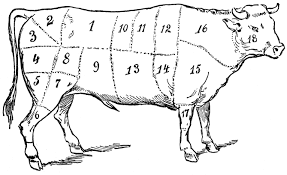Victorian Urban Legend: Ox Ring March 11, 2018
Author: Beach Combing | in : Modern , trackbackBusy day. Lots of work and final papers to grade, but would love to know whether this can be paralleled: drbeachcombing AT gmail DOT com
On the 8th of November, 1871, a public officer at Colchester reported that having seen a report in the Shipping Gazette that a bullock had been picked up by the crew of the smack Mary Ann, belonging to that port, and that in opening the said bullock a gold ring had been taken out of it. He had, in execution of his official duties, directed his deputy to call the master of the smack for a report. The master at once handed the ring to the deputy, who sent it to the proper department in London. On further inquiry it appeared that Captain Tye, the master of the Mary Ann, picked up a bullock on the 28th of October, at 2.30 p.m., not 29th as had been said. The steamer from which the bullock was supposed to have been lost appeared to be a foreigner, and she passed the Spitway Buoy at noon, on her way to the entrance of the Thames. The bullock was quite warm when the crew of the Mary Ann got it, and they cut it open to get fat to grease their rigging, when the ring was found. There is no doubt, therefore, that the ring was inside a bullock that had formed part of the cargo of ship, and that the bullock and all in came under the definition of wreck, to be dealt with by the proper public officer under the Merchant Shipping Acts. The next step was to identify the steamer that entered the Thames with cattle on the day named. This was attempted, and her name first given was the S. Eiderstadt, but the officer reported that there was no record in the office books of any cattle missing from that vessel. Another department of the Government was then applied to, and from their reports and records it appeared that the only ship reporting the loss of cattle overboard on the 28th October, 1871, was the Adler. The report of that ship being that an ox which was thrown overboard at sea died from exhaustion through stress of weather. So far, the Eiderstadt appeared from the description to be the ship that passed Tye, but she had made no report of losing cattle. On the other hand the Adler had made such a report. At this stage of the proceedings a letter was received by Captain Tye from a gentleman of Nordenhamn stating that he had read in the Shipping Gazette of the finding of the golden ring, with an inscription and the date 1869 in the stomach of an ox. It appeared from the letter of this gentleman that the lady whose name is on the ring is the wife of a wealthy tanner. But still there was nothing yet to show when the ring was lost, when it was supposed to have been swallowed by an ox, or by what ship the ox was conveyed. The gentleman at Nordenhamn was therefore asked to obtain from the farmer some further information. It then appeared that in the year 1869 a wealthy farmer married the lady whose name is on the ring; on which occasion, according to the German custom, they exchanged rings. The farmer, it appears, continued after marriage to attend to his flocks and herds, but one day last winter, whilst making flour balls on which to feed his oxen, he lost his wedding ring. He gave it up as a bad job, as he did not know which flour ball it was in, or which ox, if any, had swallowed it. He subsequently sold seven oxen to a dealer of the country. These oxen were shipped to England as part of cargo by the Adler on the 26th October. One ox, which proved eventually to have been one of our farmer’s, was taken very sick; probably the ring and the sea together disagreed with it. It died, was supposed, from exhaustion, and was consigned to the sea, and in due course was picked up and opened by Tye. Tye is an honest sailor, and deserves all praise for his promptitude in advertising his discovery; and we trust that when the farmer and his spouse shall in after years recount to their children the giving, the losing, and finding of the golden ring, the happy pair will not fail to bestow passing word in remembrance of Captain Tye, the good British sailor, and his tight little craft the Mary Ann.— Nautical Magazine.
Morn Advert 15 Feb 1872
This has that tone of mutual back slapping so typical of British Victorian journalism. Some memories of chicken swallowing here…
Derek Bryant (via Twitter), 12 Mar 2018: makes the obvious point, but one that had completely passed me (Beach) by that there is the legend of rings beings retrieved from fish in the sea. These begin with Herodotus and then are found in several saints lives in the Middle Ages. Thanks Derek!



